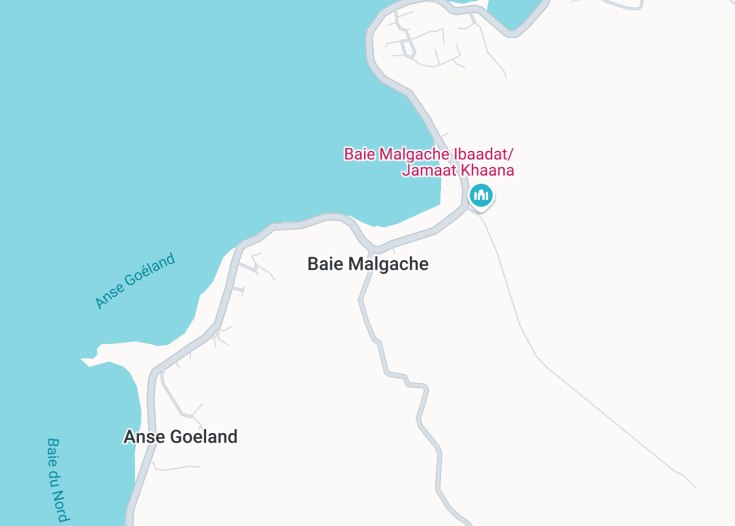Baie Malgache, nestled on the picturesque island of Rodrigues in Mauritius, offers travelers a serene retreat into nature’s lap. Renowned for its dramatic coastal scenery and vibrant marine life, the bay is a haven for eco-tourists and adventure lovers alike. Its crystal-clear waters and diverse ecosystem make it an ideal spot for snorkeling, while the surrounding landscapes promise exhilarating hiking experiences. Embrace the tranquil ambiance and the warm hospitality of the local community, making Baie Malgache a captivating destination for those seeking a blend of adventure and relaxation.
Before heading to Baie Malgache, ensure to pack sunscreen and appropriate hiking gear to fully enjoy the natural trails and sun-drenched beaches comfortably.
Consider visiting Baie Malgache during the cooler months from May to October, when the weather is more temperate, enhancing your outdoor activities and exploration.
Top things to do & see in Baie Malgache
Select the following sights and activities to discover best tickets and tours available in Baie Malgache.
Baie Malgache: A Serene Escape in Rodrigues
| Country | Rodrigues (Mauritius) |
| Time in Baie Malgache | GMT+4 |
| Language spoken | English and French |
| Population | Approximately 2000 (Local Government records, 2023) |
| Currency | Mauritian Rupee (MUR, ₨) |
| Airports | Sir Gaëtan Duval Airport (10 mi / 16 km). |
Baie Malgache, located in the small but spirited island of Rodrigues, a part of Mauritius, is rich in both natural beauty and cultural heritage. This coastal village, nestled in the southeastern part of the island, boasts pristine beaches and turquoise waters, making it a paradise for beach lovers and water activities enthusiasts. The history of Baie Malgache intertwines with the broader history of Rodrigues Island, which was once a haven for pirates before evolving into a secluded fishing community.
Over the years, Baie Malgache has developed into a tranquil tourist destination that remains relatively untouched by commercial tourism, offering a genuine taste of island life. Local inhabitants of Baie Malgache live predominantly simple lives, engaging in fishing and small-scale agriculture, preserving the traditional Rodriguan lifestyle. The unique charm of this place lies in its ability to blend simplicity with breathtaking natural landscapes.
Baie Malgache is also an exceptional place for nature lovers. The area is surrounding by rich marine life and protected zones, ideal for snorkeling and diving to explore coral reefs and the variety of sea life. The local government has taken measures to preserve its natural resources, providing visitors with the opportunity to enjoy unspoiled nature. The community’s commitment to sustainable practices is evident in their tourism offerings.
Local guesthouses and eco-lodges are prevalent, many using solar power and rainwater harvesting, reflecting the community’s respect for the environment. Festivals and local events, such as traditional fishing competitions and cultural festivals, are times when visitors can really engage with the community and experience the authentic Rodrigues lifestyle. These events often feature music, dance, and traditional Rodriguan cuisine, providing a deep dive into the island’s vibrant culture.
One cannot talk about Baie Malgache without mentioning its warm, welcoming residents who are ever-eager to share their traditions and picturesque homeland with visitors. This hospitable nature, combined with stunning natural beauty, makes Baie Malgache a top choice for those seeking a peaceful retreat within Rodrigues.
Where is Baie Malgache?
Baie Malgache is a charming village on the southeastern coast of Rodrigues Island in Mauritius, known for its serene beaches and traditional lifestyle.
Distances:
| Route | Distance by car | Time by car |
|---|---|---|
| Port Mathurin to Baie Malgache | 15 miles (24 km) | 30 minutes |
| Mont Lubin to Baie Malgache | 13 miles (21 km) | 25 minutes |
What is Baie Malgache famous for?
Baie Malgache is famous for its incredible coastal scenery, cultural richness, and a vibrant community that embodies the relaxed and joyful spirit of Rodrigues Island.
History
Early Settlement and Discovery (1500s – 1700s)
Baie Malgache, positioned on the southern coast of Rodrigues Island in Mauritius, has a history that is intertwined with the broader narrative of the island’s discovery and settlement. The bay, known for its strategic geographic location, played a pivotal role during the early years of exploration. Named after the Malagasy settlers who arrived from Madagascar, the bay’s origins trace back to the era when European explorers mapped the Indian Ocean. The first recorded visit by Europeans was by the Portuguese navigator Diogo Rodrigues in the mid-16th century, who named the island after himself.
Colonial Era (1700s – 1960s)
During the 18th century, Rodrigues came under French control, and Baie Malgache saw enhanced activity as part of colonial exploitation initiatives. The bay area became instrumental due to its natural harbours and abundant fish resources. Throughout the years, it turned into a minor port where ships could anchor safely while traversing the Indian Ocean. Sugar plantations and lime production sites started to develop around the bay as the island’s economy pivoted under French and, subsequently, British rule following the Napoleonic Wars. After 1814, when Mauritius (including Rodrigues) was ceded to Britain, Baie Malgache benefited from mild infrastructure enhancements, yet retained much of its idyllic nature.
Post-Independence Era to Present Day (1968 – Present)
After Mauritius gained independence in 1968 and subsequent autonomy for Rodrigues in the 21st century, Baie Malgache began an era of ecological awareness and community-focused development. Conservation efforts to preserve its pristine beaches and marine biodiversity have been prioritized over commercial development, fostering sustainable tourism as a path for local economic stability. Today, Baie Malgache is still relatively untouched by mass tourism, with efforts from local communities and the Rodrigues Regional Assembly focusing on maintaining its cultural heritage and natural landscape.
Visit Baie Malgache
What to see and do in Baie Malgache, Rodrigues (Mauritius)
Baie Malgache enchants visitors with its scenic vistas and tranquil beaches, offering a variety of activities:
- Explore the rugged coastlines and hidden coves ideal for photography and nature walks.
- Engage in water sports such as kayaking and snorkeling in the clear, turquoise waters.
- Visit local villages to experience Rodriguan hospitality and savour traditional cuisine.
- Take guided ecological tours to learn about the conservation of the marine and terrestrial biodiversity in the area.
Annual Events in Baie Malgache
Baie Malgache hosts several cultural and environmental events throughout the year, notably:
- The Rodrigues International Kite Festival, usually in July, celebrates the art of kite flying against the backdrop of the bay’s stunning landscape.
- Conservation Week in November focuses on educating and involving the community and visitors in preserving the natural habitat.
These events provide a glimpse into the local culture and environmental dedication of Rodrigues.
Best time to visit Baie Malgache
The ideal time to visit Baie Malgache is from April to November, during the cooler and drier months. This period offers the best conditions for outdoor activities and coincides with cultural events that showcase the region’s rich traditions and community spirit.
Is Baie Malgache worth visiting?
Baie Malgache offers a unique blend of natural beauty, cultural richness, and tranquil seclusion, making it a worthwhile destination for those seeking an off-the-beaten-path experience. While its remote location may pose accessibility challenges, the pristine environment and warm local hospitality provide profound rewards for the adventurous traveler. Balancing serenity with engaging local culture and conservation initiatives, Baie Malgache presents an enriching travel experience. Though it may not cater to those seeking luxurious resorts or bustling nightlife, it firmly appeals to eco-tourists and cultural enthusiasts.









